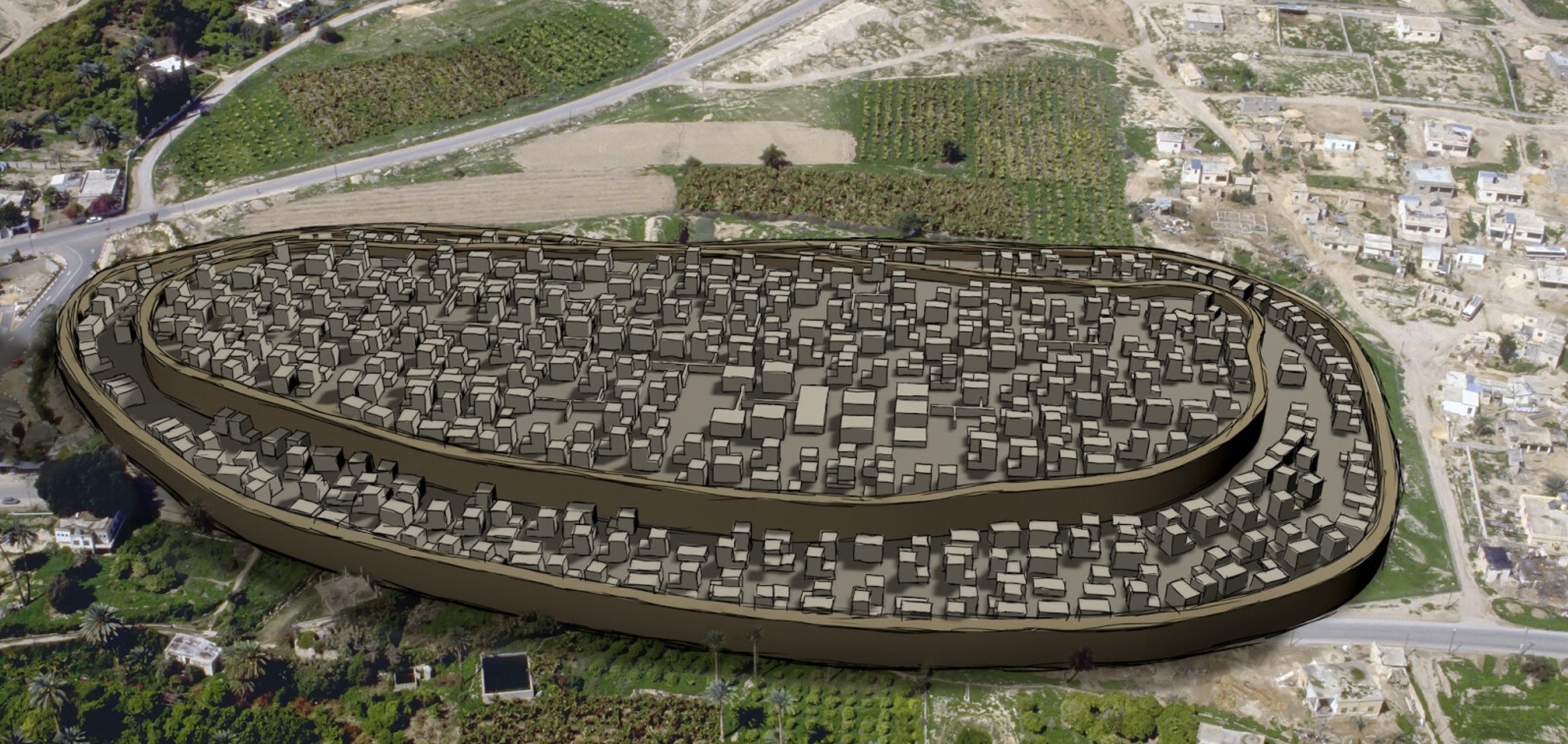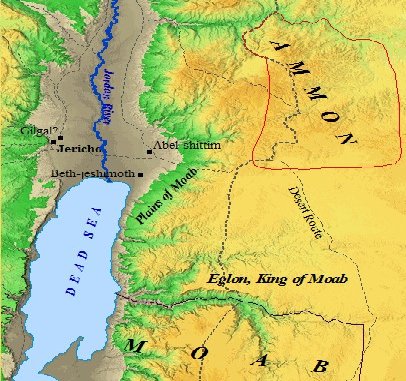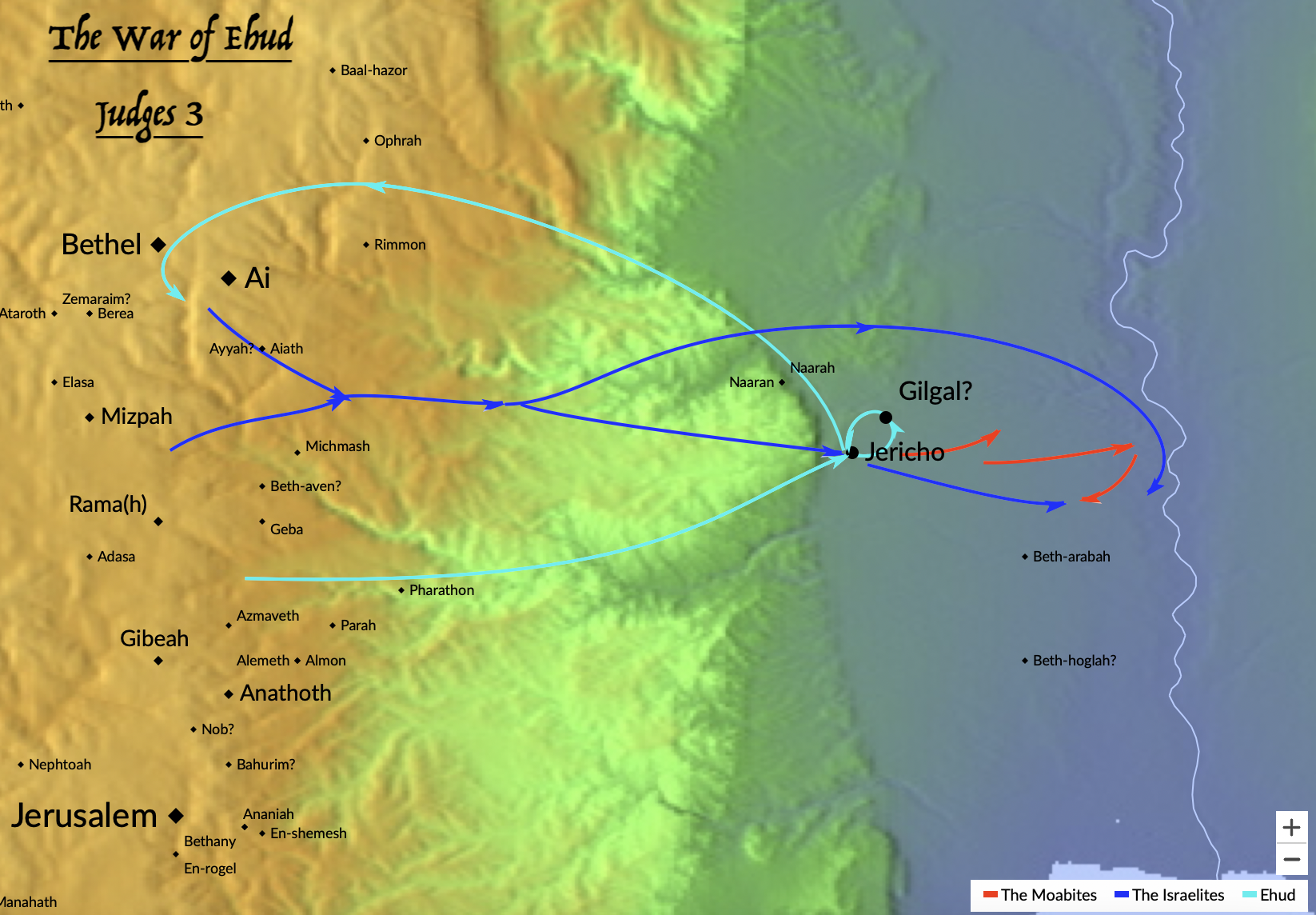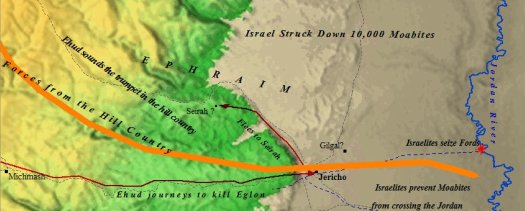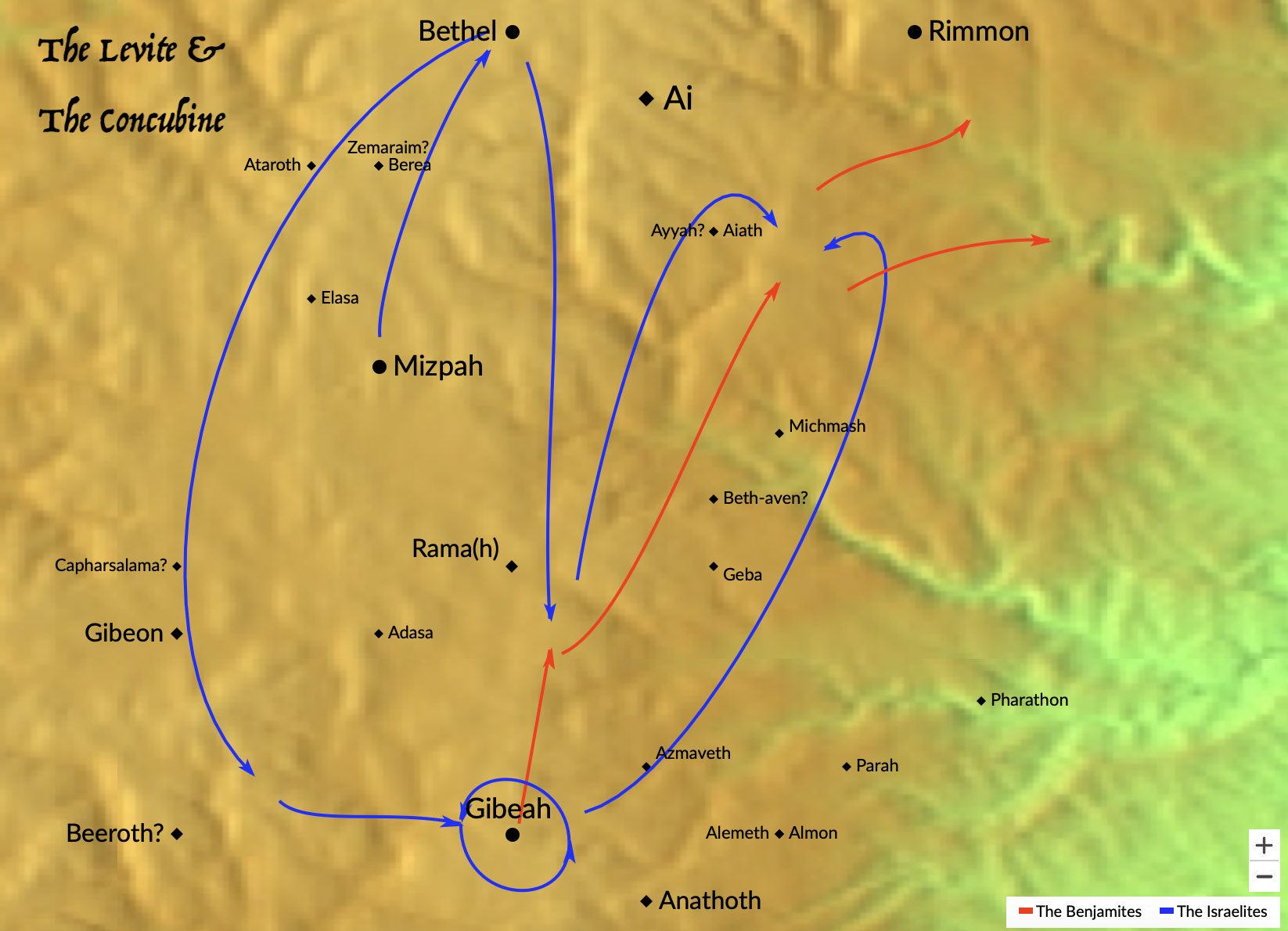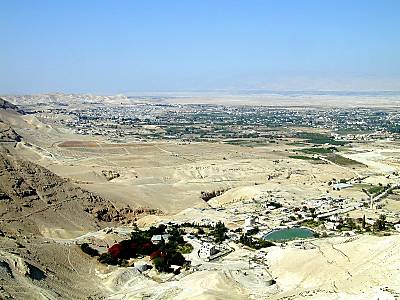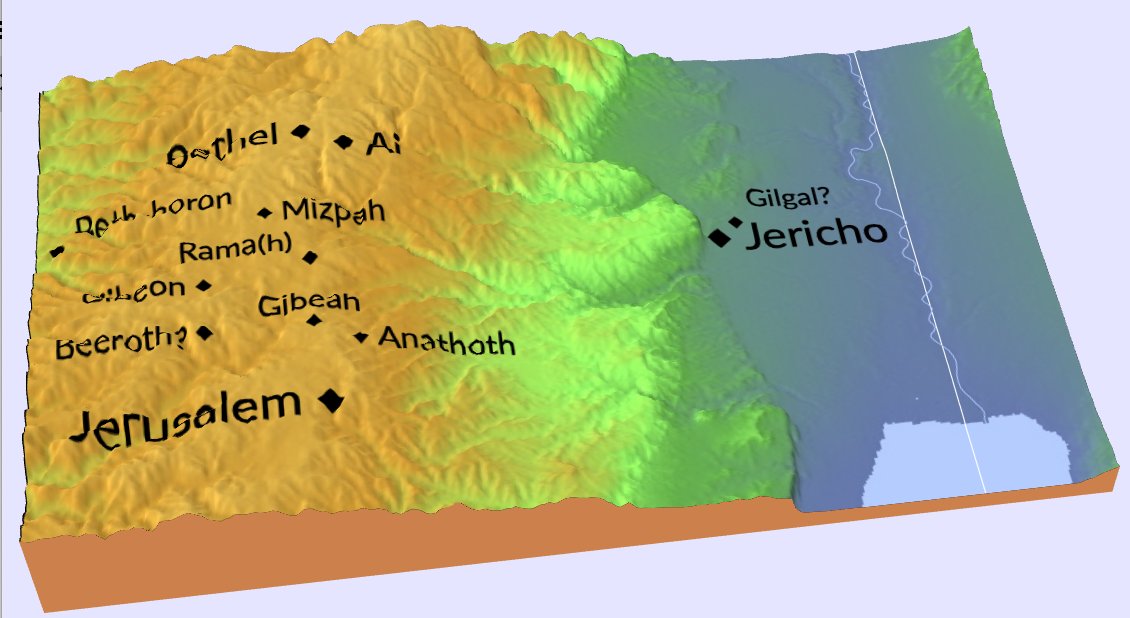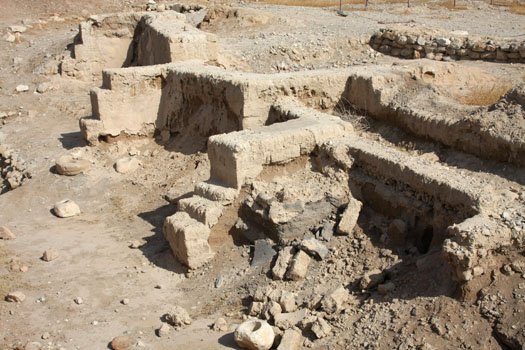VISIT OUR FACEBOOK PAGE!
The Ancient City of Jericho
Ehud & the Ancient City of Jericho (Judges 3:12-30)
The ancient city of Jericho appears in Judges 3 approximately one hundred years after the conquest under Joshua, recorded in Judges 3. The Israelites are said to have "done evil in the sight of the Lord". Consequently, God gave Eglon, King of Moab, power and authority over the Israelites in that region for 18 years.
The Bible tells us that Eglon sought the assistance of the Ammonites and Amalekites to join him in his conquest. This would have been a natural alliance, as Moabites, Ammonites, and Amalekites all shared an equal hatred for Israel.
The Moabites and Ammonites are descended from the same line. After Sodom and Gomorrah were destroyed, Lot, the nephew of Abraham, fled with his daughters to the caves around the Dead Sea. His daughters, afraid of dying without any sons, schemed together and tricked their father into sleeping with them. The incestuous relationship produced two male children.
The oldest daughter bore Moab, the progenator of the Moabites, and the younger bore Benammi, the ancestor of the Ammonites. The Amalekites were descendants of Esau. Esau was the eldest son of Isaac , and had a younger brother named Jacob. Twice in the Bible Jacob manipulates Esau, once taking his birthright, the second taking his blessing. Jacob would later produce eleven sons, out of which the twelve tribes ( 1 tribe split into 2 tribes, thus yielding 12 ) of Israel were founded.
Thus, the Amalekites would have felt a deep seeded resentment of Israel, and in fact had attacked the Israelites in the desert of Sinai during the Exodus from Egypt. Ammon and Moab, and even Egypt, did not lack motivation nor desire to destroy Israel. Judges 3:13 reveals that this alliance, under the leadership of Eglon, King of Moab, attacked Israel and drove the Israelites back.
They reclaimed land north of the Argon River and seized control across the Jordan River . They took possession of the ancient city of Jericho, or, "The City of Palms" (3:13), and enslaved Israel for 18 years. The ancient city of Jericho fell into the hands of Eglon, thus Israel lost a strategic city leading to their heartland.
God, in typical God-fashion, sends an unlikely deliverer. This man was Ehud described in Judges 3:15.
"But when the sons of Israel cried to the Lord, the Lord raised up a deliverer for them, Ehud the son of Gerar, the Benjamite, a left-handed man."
Ehud was from the tribe of Benjamin. The tribe of Benjamin was to later become a target of aggression and barely escaped total annihilation by the other tribes of Israel in an unfortunate civil war. The ancient city of Jericho lay within the tribal boundaries of Benjamin.
Ehud translates, "he that praises", thus, he was a seemingly righteous man. However, the fact Scripture indicates he was left-handed provides an interesting fact about Ehud. The more literal interpretation is, "was hindered in his right hand". The implication is one of an inability to used the right hand. Ehud, thus, may have been disabled in the right hand.
The Bible tells us the "sons of Israel" had sent the tribute to Eglon by the hands of Ehud. Ehud was the bag man. As a one handed man, Ehud posed no threat to the King. However, he had trained himself secretly, under the Lord's instruction, and was ready for his mission.
Not only was Ehud carrying the tribute, but he was carrying a double edged sword as well. Scripture relates Ehud had fashioned "a sword which had two edges, a cubit in length". Ehud strapped this double edged sword on his right thigh, underneath his cloak. Scripture said the sword was a "cubit" in length. A biblical cubit was a measurement of length based on the distance between the tip of the middle finger and the elbow.
Generally, cubits ranged from 17 to 22 inches in length. The sword, thus, was just over a foot-and-a-half long. Ehud had taken on the role of assassin. Now he was to play his part.
Though Scripture does not go into detail about the route Ehud took, he approached the ancient city of Jericho from the north. He and his men started the attack from the hill country, which lay to the west of Jericho. The road plunged precipitously into Jericho from the hill country above.
JUDGE EHUD SNUCK INTO JERICHO & KILLED EGLON, THE MOABITE KING OPPRESSING ISRAEL. HE THEN SIGNALED FOR THE REST OF ISRAEL TO PURSUE THE MOABITES.
He brought the tribute to Eglon, "who was a very fat man (3:17)", stealthily carrying the dagger as well. Ehud then left with his men for home. However, shortly after departing Ehud turned back feigning a secret message for the King. Judges 3:20-22 describes Ehud's fearless act once alone with the King.
"Ehud then approached him while he was sitting alone in the upper room of his summer palace and said, 'I have a message from God for you.' As the King rose from his seat, Ehud reached with his left hand, drew the sword from his right thigh and plunged it into the King's belly. Even the handle sank in after the blade, which came out his back. Ehud did not pull the sword out, and the fat closed in around it."
Ehud left the weapon inside of the fat man. He then snuck out of the palace, avoided the guards and fled. The exact location of Seirah is unknown, however, the fact he was able to signal the other tribes with a trumpet suggests it was in one of the nearby valleys or mountains. This part of the hill country, sometimes called the hill country of Ephraim, rested on the borders of the tribes of Benjamin and Ephraim. Israel would have put aside petty tribal differences to drive out foreign aggression.
Ehud, in fact, led a band of men from these united tribes through the ancient city of Jericho to the banks of the Jordan and seized some nearby fords. This prevented the Moabites, confused from the assassination of their king, from fleeing back to Moab. Israel's forces then caught up with their enemies and slaughtered "about ten thousand Moabites" (3:29).
Scripture concludes by stating Moab was subdued that day, "under the hand of Israel". The wording here is interesting and parallels Ehud's underhanded assassination of King Eglon.
It is also significant to point out Scripture does not make note of the walls of Jericho. The walls of Jericho seem to have not been rebuilt to their former stature. Approximately 100 years before Ehud, Joshua and the Israelites had famously conquered Jericho by bringing the formidable walls to the ground in a heap.
In Ehud's day the ancient city of Jericho appears somewhat diminished from its earlier status. Ehud and his men seem to freely move with ease through and around the city. Ehud's daring assassination in ancient Jericho, driving out the foreign occupiers, brought 80 years of peace and freedom to the region for Israel.
SHARE YOUR THOUGHTS ON ANCIENT JERICHO Have you visited Jericho before? Do you live there? Click on the above link to give us your insights, comments, questions, and thoughts!
Study Resource
AVM Presentations offers The Second Great Battle of Jericho: The Story of Biblical Archaeology [VHS], also offered on DVD from Amazon.com. This video will help Christians realize that the Bible is under attack today as never before! The archaeology behind Jericho is a major point of emphasis for critics of the Bible. Join Dr. Bryant Wood, Director of Associates for Biblical Research, as he uncovers the truth behind the archaeology at ancient Jericho! Click on the link below to visit Amazon.com and find out about The Second Great Battle of Jericho: The Story of Biblical Archaeology!
The Second Great Battle of Jericho: The Story of Biblical Archaeology [VHS]
The Levite and the Concubine
Judges 19-21 describes an incident involving a certain Levite "who lived in a remote area in the hill country of Ephraim".
Though the city of Jericho is not mentioned by name, this passage involves all the towns of the Benjamites, and Jericho was one of those towns. This story gains in importance when one views the archaeology of the ancient city of Jericho.
This Levite was said to have taken a concubine from Bethlehem in Judah. The concubine was unfaithful, did not like the Levite and went back to her father's house. The Levite went in pursuit of her, and upon arriving at her house persuaded her to return with him. On their way back to the Levite's house, they stopped in Gibeah. Here they were invited to stay the night at a local man's house.
As the night progressed, evil men from the town demanded the Levite come outside so they could have sex with him. The man hosting the Levite urged the evil townsmen to leave his guest alone. However, he would give them his virgin daughter and the concubine in exchange, just so they would not leave empty-handed.
Scripture reveals the concubine was sent outside, and the evil men of the city "raped her and abused her throughout the night, and at dawn they let her go" (Jud. 19:25).
When her master awoke the next morning, he stepped outside to find his concubine had "fallen in the doorway of the house, with her hand on the threshold" (19:27) The Levite's response in verse 28 gives insight into the heart of this priest.
"And he said to her; 'Get up and let us go,' but there was no answer. Then he placed her on the donkey; and the man arose and went to his home."
The Levite, an Israelite priest set aside by God Himself, put her on his donkey, for she was unable to move, and returned home. He was not concerned in the least with her well-being. The Levite's callousness appears very ungodly and coldhearted, completely in opposition to the compassion and mercy YHWH demands, especially from His priests (the Levites). Upon reaching his house, the Levite priest performs an atrocious act even more ungodly. Scripture says he;
"took a knife and cut up his concubine, limb by limb, into twelve parts and sent them into all the areas of Israel"(19:29)
After each of the tribes received its gruesome package the eleven tribes came together in equal rage. All of Israel was shocked, horrified and angry, as nothing like this had happened ever before. This graphic story attests to the wickedness and godlessness of Israel in these days. The Bible then tells how all the Israelites, "from Dan to Beersheba and from the land of Gilead" united as one and rose up against the tribe and towns of Benjamin.
The Benjamites were said to have mustered over 27,000 fighting men. They were going up against 400,000 men from the rest of Israel. Controversy exists surrounding certain numbers in the Bible - such as this one and the number of people involved in the Exodus. For argument's sake, we will treat the numbers in this narrative as the Bible in our English version translates it.
Though completely outnumbered and overwhelmed, the Benjamites defeated their Israelite brothers during the first three battles. The tribe of Benjamin possessed mighty warriors, well-known and feared for their fierceness in battle.
Despite Benjamin's initial success in the first three battles, the fourth would prove fatal. The fourth battle saw all but 600 Benjamites killed. The survivors fled to the desert. The tribe of Benjamin was mortally crippled.
Judges 20:48 describes how Israel then went from town to town setting fire to all the towns they came across belonging to the tribe of Benjamin. Thus, the ancient city of Jericho was burned to the ground a second time. This account of Jericho burning is left out by archaeologists when describing the fires at Jericho because the city is not mentioned specifically by name.
Yet, the ancient city of Jericho was a town of Benjamin, and the Bible states explicitly that all the towns of Benjamin were burned to the ground.Thus it can be reasonably assumed the ancient city of Jericho was once again razed - this time by rival Israelite tribes.
THE ANCIENT CITY OF JERICHO & KING DAVID
II Samuel 10:5 mentions Jericho during the time of David. David had sent some of his men to Hanun, King
of the Ammonites. He wished to express sympathy to Hanun for the recent
passing of Hanun's father. Hanun, however, listened to his advisers and
seized David's men. He then shaved their heads and cut off half of
their beards, a serious insult to King David's men.
So serious was the insult that David instructed his men to stop off in Jericho and remain there until their beards had grown back. Though the ancient city of Jericho is not the central point of this passage, it does prove that it was at least meagerly occupied during this time.
Hiel and the rebuilding of Jericho (873-849 B.C.)
Under the United Monarchy David had subdued many of Israel's former enemies. He and his son Solomon expanded Israel's borders to a greater extent than any king since.
After King Solomon's death, when the Kingdom split into Judah and Israel, geographic enemies plotted and planned the demise and overthrow of the weakened Davidic Monarchy. Both Israel and Judah became vulnerable to foreign invasion. Two such enemies were Moab and Edom. Moab and Edom were located just east of the Jordan River. Jericho was the main city buffering the Moabite/Edomite threat from the heartland of Judea, and as the powers east of the Jordan River continued to threaten Israel the ancient city of Jericho gained in strategic importance.
This threat from the east was dormant under David and Solomon. However, as King Jehoshaphat of Judah came into power upon Solomon's death, the Moabites and their allies the Ammonites mustered enough strength torevolt and test the new king.
The Israelite leadership had anticipated this threat as the Moabites and Ammonites were constantly a thorn in their side. King Jehoshaphat of Judah entered into a marriage alliance with King Ahab of Israel (Samaria). Jehoshaphat then began to fortify all the cities of Canaan in anticipation of war from these neighboring threats.
I Kings 16:34 makes mention of this fortification effort and its effects on the ancient city of Jericho. It is important to keep in mind that Ahab and Jehoshaphat were contemporaries, the former King of Samaria (Israel), and the latter King of Judah.
"In Ahab's time, Hiel of Bethel rebuilt Jericho. He laid its foundations at the cost of his firstborn son Abiram, and he set up its gates at the cost of his youngest son Segub, in accordance with the word of the Lord spoken by Joshua, son of Nun."
The curse upon the ancient city of Jericho had finally been
fulfilled. Though Hiel lost his two sons, he had rebuilt the ancient city of Jericho. Since its destruction by Joshua, the ancient city of Jericho had remained in the very least an outpost from David until the 9th century BC.
The fact that Hiel did rebuild the city is also seen in the route of attack taken by Moab and Ammon. II Chronicles 20:2 outlines their attack coming from Edom, east of the Dead Sea. The two countries marched around the Dead Sea and attacked from the south.
At the time that King Jehoshaphat received this message it is said that the invading army was already in Tamar. Thus, the invaders came up through the Negeb.
The more direct route of invasion from east of the Jordan River would have led through the ancient city of Jericho itself, which rested less than 20 miles east of Jerusalem, the capital city of Israel. This would seem to imply the Moabites and Ammonites felt Jericho was too strong of a city and its influence in that region too strong - thus they took the route of less resistance and went around Jericho.
Though Jericho is not the central point of this passage, it does prove that it was at least meagerly occupied during this time and continued to exert some sort of influence in the region. The ancient city of Jericho had survived, despite the burning to the ground for a
second time on account of the tribe of Benjamin's evil.
Back to Top of Ancient City of Jericho
Back to Jericho
Back to Home Page
SAMUEL the SEER
Now Available in Print & eBook on Amazon!!
POPULAR TOPICS
Learn more about these popular topics below. The Bible is full of fascinating stories, characters and mysteries!
BIBLE MAPS
Explore the land of the Old Testament! View these maps of the Bible.
